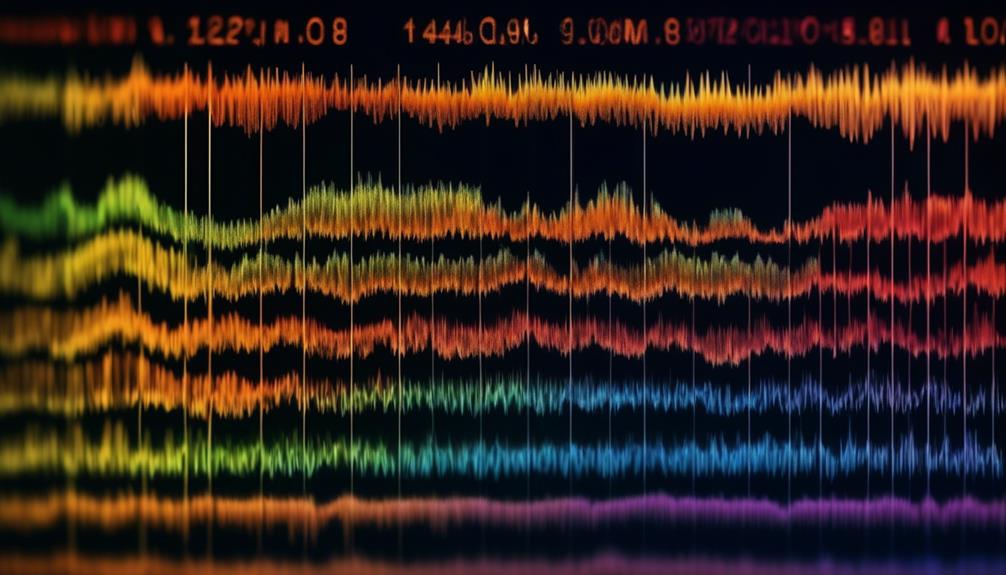
Are you fascinated by the intricate ways in which animals communicate? Have you ever wondered about the linguistic complexities hidden within the calls of emus?
Emu calls, a fascinating subject of study, offer a unique lens through which we can explore the field of communication analysis. In this discussion, we will delve into the classification of emu calls, examine vocalization patterns and their role in social interactions, analyze the structure and syntax of these calls, and seek to understand the meaning behind their vocalizations.
By exploring the linguistics of emu calls, we uncover not only the fascinating world of these magnificent creatures but also gain valuable insights into the broader realm of linguistics research.
Key Takeaways
- Emu calls serve various functions, including territorial display, courtship behavior, and alerting to danger.
- Emu communication involves pitch variability, rhythm and tempo, duration and intensity, call structure, and complexity.
- Emu calls play a crucial role in social interactions, mate selection, social dynamics, and breeding success.
- Studying emu communication provides insights into the evolution of vocalization systems and implications for human language development.
Emu Call Classification

Emu call classification involves the systematic analysis and categorization of the various vocalizations produced by emus, using scientific methods to understand their meanings and functions. Through vocalization analysis, researchers have been able to identify distinct types of emu calls and their specific purposes.
One of the most common types of emu calls is the booming call. This call is characterized by a deep, resonant sound that can be heard from several kilometers away. It's believed to serve as a territorial display, signaling the presence of a male emu and warding off potential rivals.
Another type of emu call is the drumming call. This call is produced by the rapid vibration of the emu's throat and is often associated with courtship behavior. Male emus use the drumming call to attract females and establish their dominance.
The alarm call is another important vocalization made by emus. This call is characterized by a loud, high-pitched sound and is used to alert other emus of potential danger. It's often heard when a predator is nearby or when there's a sudden disturbance in the environment.
Vocalization Patterns in Emu Communication
Researchers have observed distinct vocalization patterns in emu communication, providing valuable insights into their social interactions and behaviors. Vocalization analysis plays a crucial role in understanding the acoustic communication of these fascinating creatures.
Here are four key observations regarding emu vocalizations:
- Pitch variability: Emus exhibit a wide range of pitch variations in their calls, which can convey different meanings. Higher pitches are often associated with alarm or aggression, while lower pitches may indicate contentment or submission.
- Rhythm and tempo: Emus have a unique rhythmic pattern in their vocalizations, with a distinct tempo that varies depending on the context. Slower, deliberate calls may be used during courtship or territorial disputes, while faster, frenetic calls are common during social gatherings or when emus are excited.
- Duration and intensity: The duration and intensity of emu calls can convey important information about the urgency or significance of a situation. Longer and louder calls are often associated with more intense emotions, such as fear or distress, while shorter and softer calls may indicate a calmer state.
- Call structure: Emu vocalizations consist of various elements, including distinct syllables and repeated patterns. These structural components contribute to the complexity and richness of their communication, allowing emus to convey nuanced messages to one another.
Through vocalization analysis and an understanding of acoustic communication, we can gain a deeper appreciation for the intricate social dynamics and behaviors of emus.
The Role of Emu Calls in Social Interactions

The vocal calls of emus play a crucial role in shaping their social interactions and can provide valuable insights into their behaviors and relationships. Emu calls serve as a means of communication between individuals, facilitating various social interactions such as mate selection and territorial defense. Understanding the role of emu calls in these interactions is essential for gaining a deeper understanding of emu behavior and their social dynamics.
One fascinating aspect of emu calls is their role in mate selection. Male emus produce a booming call during the breeding season to attract females and establish their dominance. These calls are characterized by their deep, resonant quality, which can carry over long distances. By emitting these distinctive calls, male emus can signal their fitness and availability to potential mates, ultimately influencing mate selection and breeding success.
Furthermore, emu call variations can be observed across different regions. Research has shown that emus from different geographical locations may exhibit slight variations in their vocalizations. These variations may be influenced by factors such as habitat, climate, and genetic differences. Studying these regional variations in emu calls allows researchers to gain insights into the evolutionary history and adaptation of these birds.
Emu Call Structure and Syntax
An examination of the structure and syntax of emu calls reveals key patterns and features that contribute to their communicative effectiveness. Emu call evolution is a fascinating subject that sheds light on how these vocalizations have developed over time. Through acoustic analysis of emu vocalizations, researchers have identified several noteworthy characteristics:
- Rhythmic Patterns: Emu calls often follow a distinct rhythm, with repeated sequences of short and long vocalizations. This rhythmic pattern creates a sense of anticipation and urgency, capturing the listener's attention.
- Pitch Variation: Emu calls exhibit a wide range of pitch variation, from low and rumbling to high and piercing. This variability allows emus to convey different emotions and messages, enhancing their communicative repertoire.
- Call Sequencing: Emu calls are often organized into specific sequences, where different calls are combined in a meaningful way. These sequences can convey complex messages, such as warning signals or territorial claims.
- Temporal Structure: Emu calls also exhibit a precise temporal structure, with specific durations and intervals between vocalizations. This temporal organization contributes to the overall clarity and intelligibility of the call.
Understanding the Meaning Behind Emu Vocalizations

By analyzing the acoustic properties of emu vocalizations, one can gain insight into the nuanced meanings conveyed through their unique calls. Emu call acoustics play a crucial role in understanding the complex communication system of these fascinating birds. To better grasp the significance of their vocalizations, let us delve into the meaning behind emu calls.
Emus, like many other animals, use vocalizations to communicate with one another. Through a combination of pitch, duration, and rhythm, emus convey a wide range of messages such as warning signals, courtship displays, and territorial claims. Understanding the meaning behind these vocalizations can provide invaluable insights into their social dynamics and behavior.
To illustrate the diversity of emu calls and their potential meanings, the following table showcases some common emu vocalizations and their corresponding interpretations:
| Emu Call | Meaning |
|---|---|
| Deep, booming call | Territory defense |
| High-pitched call | Alarm or danger |
| Soft, rumbling call | Courtship or mating invitation |
Emu call evolution has likely shaped these acoustic properties over time, allowing emus to effectively communicate within their social groups and environments. Through careful analysis and interpretation, researchers can unlock the secrets hidden within these vocalizations, shedding light on the intricacies of emu communication.
Implications of Emu Communication for Linguistics Research
Studying the communication patterns of emus offers valuable insights into the field of linguistics, presenting opportunities to explore the evolution of vocalization systems and their potential implications for human language development. Emu calls, with their distinct qualities and communicative functions, provide a unique perspective on language evolution and the comparative animal communication. Here are some key implications to consider:
- Emu vocalizations exhibit a complex system of calls, each serving a specific purpose. This mirrors the intricate nature of human language, suggesting that similar communication strategies may have evolved in both species.
- By analyzing the structure and syntax of emu calls, linguists can gain a deeper understanding of the fundamental building blocks of language. This knowledge can shed light on the origins and development of linguistic patterns in humans.
- Comparing the vocalizations of emus to those of other animals allows researchers to identify common features and differences. This comparative approach helps uncover universal aspects of communication systems and elucidates the role of cultural factors in shaping language.
- Emu communication provides a unique opportunity to study the interplay between vocalizations and nonverbal cues, such as body movements and facial expressions. This holistic understanding of communication can contribute to our comprehension of the multimodal nature of human language.
Through the study of emu communication, linguistics research gains insights into the evolution of vocalization systems and their implications for human language development. This comparative approach allows for a deeper understanding of the fundamental principles underlying language and the intricate relationship between humans and animals in the realm of communication.
Frequently Asked Questions
How Many Different Types of Emu Calls Are There?
There are various types of emu calls, each with its own classification. Understanding the ethological significance of these vocalizations is crucial in analyzing emu communication.
Do Emus Use Vocalizations for Mating Purposes?
Emus use vocalizations, including low booming calls, for mating purposes. These calls play a crucial role in territorial disputes and social communication. The evolution of emu calls highlights their significance in establishing and maintaining intimate connections within the emu community.
Are Emu Calls Influenced by Environmental Factors?
Emu call variations can be influenced by environmental factors, such as habitat and weather conditions. These impacts on emu vocalizations are observable and can provide insight into the linguistic aspects of their communication.
Can Emu Calls Be Used to Distinguish Between Individual Emus?
Yes, emu calls can be used to distinguish between individual emus. Through emu call analysis, researchers have identified unique vocal patterns that serve as a form of individual emu identification.
Are Emu Vocalizations Similar to Those of Other Bird Species?
Emu vocalizations differ from those of other bird species. A comparative analysis reveals unique patterns and frequencies. Understanding the purpose of these calls has ethological significance, shedding light on emu communication strategies.
Conclusion
In conclusion, the linguistics of emu calls provide fascinating insights into their communication patterns. By classifying their calls and analyzing their vocalization patterns, we can understand the role of emu calls in social interactions.
Additionally, studying the structure and syntax of emu calls allows us to decipher their meaning. This research has significant implications for linguistics, shedding light on the complex nature of animal communication.
How might further exploration of emu vocalizations enhance our understanding of language development?




